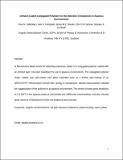Files in this item
Ormosil-coated conjugated polymers for the detection of explosives in aqueous environments
Item metadata
| dc.contributor.author | Gillanders, Ross N. | |
| dc.contributor.author | Campbell, Iain A. | |
| dc.contributor.author | Glackin, James M. E. | |
| dc.contributor.author | Samuel, Ifor D. W. | |
| dc.contributor.author | Turnbull, Graham Alexander | |
| dc.date.accessioned | 2018-11-03T00:47:55Z | |
| dc.date.available | 2018-11-03T00:47:55Z | |
| dc.date.issued | 2018-03-01 | |
| dc.identifier | 251446329 | |
| dc.identifier | caba110e-eee7-4fdc-beba-d572e18563bb | |
| dc.identifier | 85034840124 | |
| dc.identifier | 000424178000058 | |
| dc.identifier.citation | Gillanders , R N , Campbell , I A , Glackin , J M E , Samuel , I D W & Turnbull , G A 2018 , ' Ormosil-coated conjugated polymers for the detection of explosives in aqueous environments ' , Talanta , vol. 179 , pp. 426-429 . https://doi.org/10.1016/j.talanta.2017.10.062 | en |
| dc.identifier.issn | 0039-9140 | |
| dc.identifier.other | ORCID: /0000-0002-8825-3234/work/38331086 | |
| dc.identifier.uri | https://hdl.handle.net/10023/16387 | |
| dc.description | This project has received funding from the TIRAMISU project, funded by the European Commission’s Seventh Framework Programme (FP7/2007-2013) under grant agreement 284747, and the Engineering and Physical Sciences Research Council under grants EP/K503940/1, EP/K503162/1, EP/N509759/1. IDWS acknowledges a Royal Society Wolfson Research Merit Award. The research data supporting this publication can be accessed at http://dx.doi.org/10.17630/3875a099-bb75-4ae1-82e5-0b98b6b7ebc6. | en |
| dc.description.abstract | A fluorescence-based sensor for detecting explosives, based on a conjugated polymer coated with an ormosil layer, has been developed for use in aqueous environments. The conjugated polymer Super Yellow was spin-coated onto glass substrates prior to a further spin-coating of an MTEOS/TFP-TMOS-based ormosil film, giving an inexpensive, solution-based barrier material for ruggedization of the polymer to an aqueous environment. The sensors showed good sensitivity to 2,4-DNT in the aqueous phase at micromolar and millimolar concentrations, and also showed good recovery of fluorescence when the explosive was removed. | |
| dc.format.extent | 353852 | |
| dc.language.iso | eng | |
| dc.relation.ispartof | Talanta | en |
| dc.subject | Organic semiconductors | en |
| dc.subject | Sol-gels | en |
| dc.subject | Aqueous explosives | en |
| dc.subject | Optical sensing | en |
| dc.subject | Super yellow | en |
| dc.subject | QC Physics | en |
| dc.subject | T Technology | en |
| dc.subject | DAS | en |
| dc.subject.lcc | QC | en |
| dc.subject.lcc | T | en |
| dc.title | Ormosil-coated conjugated polymers for the detection of explosives in aqueous environments | en |
| dc.type | Journal article | en |
| dc.contributor.sponsor | The Royal Society | en |
| dc.contributor.sponsor | European Commission | en |
| dc.contributor.sponsor | EPSRC | en |
| dc.contributor.institution | University of St Andrews. School of Physics and Astronomy | en |
| dc.contributor.institution | University of St Andrews. Condensed Matter Physics | en |
| dc.identifier.doi | https://doi.org/10.1016/j.talanta.2017.10.062 | |
| dc.description.status | Peer reviewed | en |
| dc.date.embargoedUntil | 2018-11-03 | |
| dc.identifier.grantnumber | en | |
| dc.identifier.grantnumber | en | |
| dc.identifier.grantnumber | EP/K503940/1 | en |
This item appears in the following Collection(s)
Items in the St Andrews Research Repository are protected by copyright, with all rights reserved, unless otherwise indicated.

